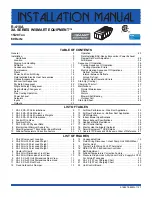
CONNECTIONS – PLUMBING
19
WARNING: Plumber
– Be Aware
The primary flow and return pipes between the storage tank(s) and the primary water heating source,
including the solar hot and solar cold pipes between the solar storage tank(s) and the solar collectors,
MUST BE
of copper, or metallic. All compression fittings must use brass or copper olives.
Plastic pipe
MUST NOT
be used, as it will not withstand the temperature of the fluid generated by the
primary heating source under certain conditions. The primary heating source may generate extremely
high fluid temperatures and high fluid pressure of 500 kPa. Plastic pipe cannot withstand these
temperatures and pressures, and
MUST NOT
be used. Failure of plastic pipe can lead to the release
of high temperature fluid and cause severe water damage and flooding.
The full length of the primary flow and return pipes
MUST BE
insulated.
The insulation must:
be of a type suitable for the application and capable of withstanding the temperature of the water
generated by the primary water heating source
The specification of the chosen insulation material should be checked with the insulation
manufacturer prior to installation as different materials may vary in temperature tolerance.
Closed cell type or equivalent insulation used between the storage tank(s) and solar collectors, if
this storage tank is part of a solar water heater installation, must be able to withstand the
temperature of the water generated by the solar collectors under stagnation conditions. Refer to
the installation instructions provided with the solar controller for full details on the insulation
requirements of the solar hot and solar cold pipes.
be at least 13 mm thick, however thicker insulation may be required to comply with the
requirements of AS/NZS 3500.4
be weatherproof and UV resistant if exposed
be fitted up to and cover the connections on both the storage tank(s) and the primary heating
source.
The insulation will reduce pipe heat losses and also assist in avoiding accidental contact with the pipe
work as high temperature water can flow from the primary heating source and the storage tank(s).
In addition, the insulation on the solar hot and solar cold pipes must also:
extend through any penetrations in the eaves, ceiling and roof
cover valves and fittings in the solar hot and solar cold pipe work
Note: Failure to observe these requirements also increases the risk of freeze damage.
The insulation is essential to assist in providing freeze protection and will offer corrosion protection to
a metal roof against water runoff over the copper pipe.
Uninsulated pipe work, including concealed in cavities and roof spaces or where it may be in contact
with a metal roof, may lead to freeze damage. The system has NO WARRANTY for freeze damage if
the solar hot and solar cold pipes are not insulated in accordance with the installation instructions.














































